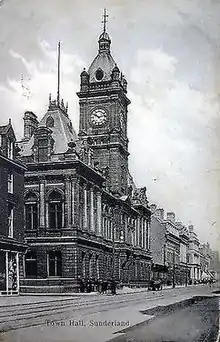Sunderland Civic Centre
Sunderland Civic Centre is a municipal building in the Burdon Road in Sunderland, Tyne and Wear, England. It is the headquarters of Sunderland City Council.
| Sunderland Civic Centre | |
|---|---|
 Sunderland Civic Centre | |
| Location | Sunderland |
| Coordinates | 54.9013°N 1.3822°W |
| Built | 1970 |
| Architect | Spence Bonnington & Collins |
| Architectural style(s) | Modern style |
 Shown in Tyne and Wear | |
History

After Sunderland became a municipal borough in 1835,[1] civic leaders initially held their meetings in the Exchange Building on High Street East which had served as the local market hall as well as the courthouse since it was completed in 1814.[2] Following the expansion of the borough council's responsibilities in the latter half of the 19th century, civic leaders decided to procure a purpose-built town hall in Fawcett Street.[2] The town hall was designed by Brightwen Binyon of Ipswich, was built by John and Thomas Tillman at a cost of around £50,000 and was officially opened by the mayor, Councillor Robert Shadforth, on 6 November 1890.[2][lower-alpha 1]
After the Second World War the town hall was also deemed unsuitable and civic leaders decided to procure a new civic centre: the site they selected had previously been occupied by a residential area known as West Park.[3] Construction of the civic centre started in January 1968.[4] It was designed by Spence Bonnington & Collins in the Modern style, built at a cost of £3.4 million and was officially opened by Princess Margaret, Countess of Snowdon on 5 November 1970.[5][6]
The design for the new low-rise building, which made extensive use of red brick, involved two connected hexagons arranged on a north–south axis: there were continuous rows of glazing with brickwork above and below on each of the floors throughout the complex.[7] The civic suite, which contained the council, jutted out of the main building to the south west.[4] The windows in the building had metal curtains which were inspired by those in the Four Seasons Restaurant in New York which rippled from the air released from concealed ventilation ducts.[8] The design received a gold award from the Royal Institute of British Architects as well as a Civic Trust Award.[4]
The building continued to serve as the headquarters of Sunderland Borough Council and became the local seat of government of the enlarged Sunderland Metropolitan District Council in 1974.[9] After Sunderland received city status in 1992,[10] Queen Elizabeth II, accompanied by the Duke of Edinburgh, visited the civic centre and unveiled the city's new coat of arms on 18 May 1993.[11]
A large stained glass window, designed by Dan Savage to commemorate the 25th anniversary of the UK miners' strike, was installed above the entrance to the council chamber and unveiled by the general secretary of the Durham Miners' Association, David Hopper, on 5 March 2010.[12]
In October 2019 construction work commenced on a new City Hall, designed by Faulkner Brown and being built by Bowmer + Kirkland at a cost of £42 million, on the former Vaux Breweries site.[13][14][15] In January 2021 The Guardian listed the Civic Centre as one of Britain's Brutalist buildings most at risk of demolition and development. It was included in Brutal North: Post-War Modernist Architecture in the North of England, Simon Phipps's photographic study of Brutalist architecture.[16]
Notes
- After the borough council had rejected all proposals for alternative use of the building, the old town hall in Fawcett Street was demolished in 1971.[2]
References
- "Sunderland: An Archaeological Assessment and Strategy" (PDF). Tyne and Wear Historic Towns Survey. 1 March 2004. p. 60. Retrieved 20 November 2020.
- "Sunderland Town Hall". Wearside Online. Retrieved 20 November 2020.
- "Ordnance Survey Map". 1955. Retrieved 20 November 2020.
- "Sunderland Civic Centre". Canmore. Retrieved 20 November 2020.
- "Thirteen golden memories of Sunderland as it looked in 1970 - but how many scenes do you remember?". Sunderland Echo. 23 March 2020. Retrieved 20 November 2020.
- "Sunderland Local Studies Stock List". Durham Images. Retrieved 20 November 2020.
- "Buildings at Risk: Sunderland Civic Centre". 20th Century Society. Retrieved 20 November 2020.
- "Tourist In Your Own Town No. 40 - The Four Seasons Restaurant". New York Landmarks. 23 June 2015. Retrieved 20 November 2020.
- Local Government Act 1972. 1972 c.70. The Stationery Office Ltd. 1997. ISBN 0-10-547072-4.
- "A History of Sunderland". Local Histories. Retrieved 20 November 2020.
- "Court Circular". The Independent. 19 May 1993. Retrieved 20 November 2020.
- "Sunderland memorial to miners' strike unveiled". BBC. 5 March 2010. Retrieved 20 November 2020.
- "Why struggling English councils are spending millions on new offices". Financial Times. 8 May 2019. Retrieved 20 November 2020.
- "B+K wins £42m Sunderland City Hall contract". PBC Today. 23 October 2019. Retrieved 20 November 2020.
- "B+K wins £42m landmark Sunderland civic hall". Construction Enquiror. 23 October 2019. Retrieved 20 November 2020.
- Lanre Bakare (3 January 2020). "Destruction of brutalist architecture in north of England prompts outcry". The Guardian. Retrieved 3 January 2020.